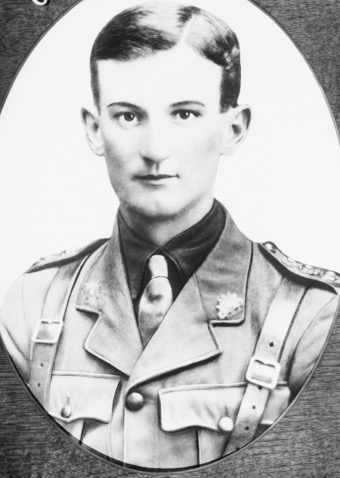Capt
Clarence Smith Jeffries
Informatie over geboorte
|
Geboortejaar: 1894 |
|
Geboorteplaats: Wallsend, Newcastle, New South Wales, Australië |
Algemene Informatie
|
Beroep: Landmeter |
Informatie legerdienst
|
Land: Australië |
|
Strijdmacht: Australian Imperial Force |
|
Rang: Captain |
|
Eenheden: — Australian Infantry, 34th Bn. (Laatst gekende eenheid) |
Informatie over overlijden
|
Datum van overlijden: 12/10/1917 |
|
Plaats van overlijden: Augustus Wood, Passendale, België |
|
Doodsoorzaak: Killed in action (K.I.A.) |
|
Leeftijd: 23 |
Begraafplaats
|
Tyne Cot Cemetery Plot: XL. Rij: E. Graf: 1. |
Onderscheidingen en medailles 3
|
British War Medal Medaille |
|
Victoria Cross Medaille — 18/12/1917 |
|
Victory Medal Medaille |
Points of interest 2
| #1 | Geboorteplaats | ||
| #2 | Plaats van overlijden (bij benadering) |
Mijn verhaal
Captain Jeffries served in the Australian Infantry 34th Battalion, part of the 9th Australian Brigade of the 3rd Australian Division. At the end of September the 34th Battalion was transferred to Belgium where they found themselves in the middle of the Battle of Passchendaele. On 12 October 1917 the Battalion carried out a disastrous attack on Passchendaele itself. The Battalion’s jumping off line was what is now Tyne Cot Cemetery, and its final objective lay just beyond Passchendaele village. The 34th Battalion was the first Battalion to advance, followed by the 35th and 36th Battalion.
At 5.25 a.m., the barrage came down. It was very weak and it was difficult to determine, which was the own barrage and which was German shell fire. The advance was slow. A first obstacle, were two concrete pillboxes. One in the north of Augustus Wood and one to the northeast of Heine House. German machine-gun fire from those positions caused several casualties and held up the centre of the advance. Captain Jeffries organised a bombing party, which rushed the strongpoints. Four machine guns and 35 prisoners were captured. 150 yards in the rear of this strongpoint was a small trench in which were up to 30 Germans. An attacking party received the order to take control of the small trench. By now the 34th had s-suffered heavy losses and it was decided to send the entire Battalion up with the 35th and 36th Battalion, in the attempt to take control over the next two objectives. The Battalions reached the second objective, the Blue Line, but suffered heavy losses, from German machine gun- and shell fire.
At 3 p.m., the Battalions received instructions to hold the line at all costs. Eventually a new line was constructed from Defy Crossing on the Ypers-Roulers Railroas to the direction of Waterfields.
Capt. Jeffries was posthumous rewarded with the Victoria Cross. After the war the remains of Capt. Jeffries were found near Augustus Wood. He was later reinterred in Tyne Cot Cemetery
At 5.25 a.m., the barrage came down. It was very weak and it was difficult to determine, which was the own barrage and which was German shell fire. The advance was slow. A first obstacle, were two concrete pillboxes. One in the north of Augustus Wood and one to the northeast of Heine House. German machine-gun fire from those positions caused several casualties and held up the centre of the advance. Captain Jeffries organised a bombing party, which rushed the strongpoints. Four machine guns and 35 prisoners were captured. 150 yards in the rear of this strongpoint was a small trench in which were up to 30 Germans. An attacking party received the order to take control of the small trench. By now the 34th had s-suffered heavy losses and it was decided to send the entire Battalion up with the 35th and 36th Battalion, in the attempt to take control over the next two objectives. The Battalions reached the second objective, the Blue Line, but suffered heavy losses, from German machine gun- and shell fire.
At 3 p.m., the Battalions received instructions to hold the line at all costs. Eventually a new line was constructed from Defy Crossing on the Ypers-Roulers Railroas to the direction of Waterfields.
Capt. Jeffries was posthumous rewarded with the Victoria Cross. After the war the remains of Capt. Jeffries were found near Augustus Wood. He was later reinterred in Tyne Cot Cemetery
Bronnen 5
|
34th Australian Infantry Battalion, Australian War Memorial, Campbell (AWM), AWM4 23/51/12). https://www.awm.gov.au/collection/C1338583 Gebruikte bronnen |
|
E. Beaver and J.W.G. Meldrum, A Short History of the 34th Battalion, AIF, (Carlton, Illawarra Press, 1957), pg. 22-24 Gebruikte bronnen |
|
First Australian Imperial Force Personnel Dossiers, 1914-1920, (National Archives of Australia, Canberra (NAA), B2455, JEFFRIES C S). https://recordsearch.naa.gov.au/SearchNRetrieve/Interface/SearchScreens/NameSearch.aspx. Gebruikte bronnen |
|
McCarthy C., The Third Ypres Passchendaele. The Day-by-Day Account, (London, Arms & Armour Press, 1995), pg. 113-115. Gebruikte bronnen |
|
Snelling S., VC's of the First World War, Passchendaele 1917, (London, Wrens Park Publishing, 2000, 1998), pg. 227-230. Gebruikte bronnen |
Meer informatie 4
|
Lives of the First World War (Imperial War Museum) https://livesofthefirstworldwar.iwm.org.uk/lifestory/7619081 |
|
Commonwealth War Graves Commission Database https://www.cwgc.org/find-records/find-war-dead/casualty-details/463369 |
|
The AIF Project (UNSW Canberra) https://aif.adfa.edu.au/showPerson?pid=153075 |
|
Namenlijst (In Flanders Fields Museum) https://namenlijst.org/publicsearch/#/person/_id=01947587-eacd-4d30-8ca3-0ae95f8eab14 |
